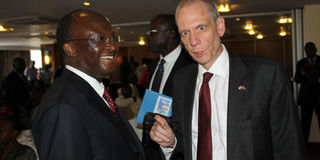Breaking News: KDF chopper crash kills five
Revealed: Counties with the highest and lowest fertility, child survival rates

Health CS James Macharia (left) with USA Ambassador to Kenya Robert Codec (right) and Planning CS Peter Mangiti (Centre) at the launch of the 2014 Kenya Demographic And Health Survey Key Indicators on April 8, 2014. PHOTO | ANTHONY OMUYA | NATION MEDIA GROUP
What you need to know:
- According to the latest survey, northeastern Kenya has the highest fertility rate in Kenya, with women in c leading nationally with an average of 7.8 children per woman. Other counties with high fertility rates nationally were West Pokot (7.2), Turkana (6.9) and Samburu (6.3).
- On average, fertility rates remained relatively higher among women living in rural areas and among those with low levels of education or no education at all. Women from poor families also recorded higher birthrates compared to their counterparts from wealthier families, with fertility rates being lowest among women from the richest families.
- Director of Medical Services Nicholas Muraguri attributed the decline in fertility rates to the considerable use of family planning among married women, which is at 58 per cent and 65 per cent among sexually active unmarried women.
Kenya’s fertility rate has been on a steady decline, falling from an average of 8.1 children per woman in the 1970s to only 3.9 per woman last year, shows the latest demographic and health survey released on Wednesday.
Incidentally, surveys conducted between 1977 and 1983 did not include women in northern Kenya and the drier parts of eastern and Rift Valley regions.
According to the latest survey, northeastern Kenya has the highest fertility rate in Kenya, with women in c leading nationally with an average of 7.8 children per woman. Other counties with high fertility rates nationally were West Pokot (7.2), Turkana (6.9) and Samburu (6.3).
“Counties with the higher total fertility rates (TFR) tend to come from arid and semi-arid parts of northern Kenya,” says the survey.
On the flipside, Kirinyaga (2.3), Nyeri (2.7), Kiambu (2.7) and Nairobi (2.7) had the lowest fertility rates nationally.
Health Cabinet Secretary James Macharia, who launched the survey in Nairobi, said TFR is a key indicator in the future health planning programmes.
Said Mr Macharia: “More women are opting for fewer children whom they can comfortably manage and provide for.”
RURAL AREAS
On average, fertility rates remained relatively higher among women living in rural areas and among those with low levels of education or no education at all. Women from poor families also recorded higher birthrates compared to their counterparts from wealthier families, with fertility rates being lowest among women from the richest families.
In rural areas, women aged between 19 and 49 years were likely to have 6.4 children, whereas their counterparts in towns were likely to have six children.
Among those aged 40 to 49 years, rural women had an average of 5.6 children compared to 3.9 for their urban counterparts. That means rural women were likely to have six children compared to four for those living in towns. Nationally, rural women had an average 4.5 children compared to 3.1 for those in towns.
“Women from households in the lowest wealth quintile (any of five equal groups) have a TFR that is more than twice that of women from the highest quintile,” says the survey.
Nationally, women from the poorest families were found to have an average of 6.4 children although those aged 19 to 49 had an exceptionally higher fertility rate at an average of 9.4 children each.
AVERAGE CHILDREN
Women in the second wealth quintile had a lower average of 4.7 children each while those in the middle had a slightly lower average of 3.8 children each. Those from families in the fourth quintile had an average of 3.1 children, compared to women from the wealthiest families who had, on average, 2.8 children each.
Generally, according to the survey, women below the age of 40 had a higher fertility rate compared to those aged between 40 and 49.
“Fifteen per cent of women age 15-19 have already had a birth, while 18 per cent have begun childbearing,” says the report, meaning that the teenagers had either given birth or were pregnant with their first child when the survey was conducted last year.
“Prevalence of early childbearing is highest in the Nyanza region followed by Rift Valley and Coast; it is lowest in central and northeastern region,” says the survey.
Director of Medical Services Nicholas Muraguri attributed the decline in fertility rates to the considerable use of family planning among married women, which is at 58 per cent and 65 per cent among sexually active unmarried women.






